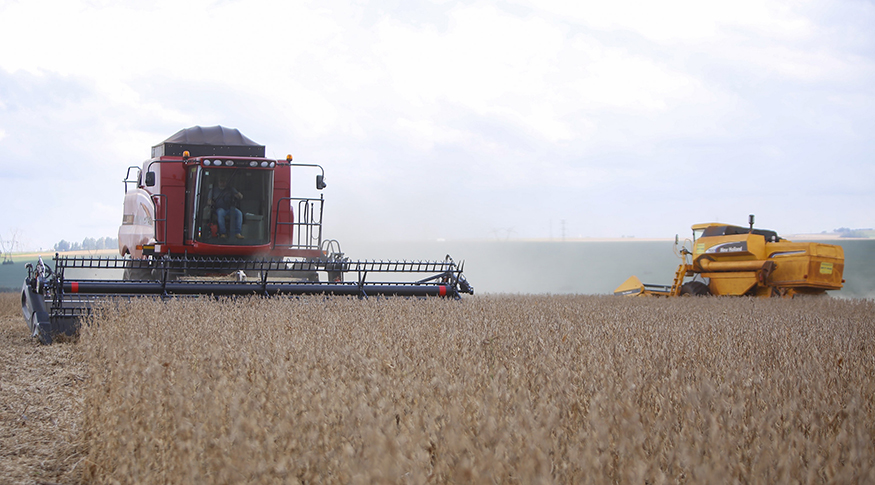Agricultural production
With 264.9 million metric tons, 2021 crop can beat record by 4.2%
April 08, 2021 09h00 AM | Last Updated: April 09, 2021 09h07 AM

The national agricultural production goes on breaking records. According to March estimate, the national grain crop of 2021 should exceed that of 2020 by 10.7 million metric tons (4.2%), totaling 264.9 million metric tons. The highlight goes to the forecast for soybeans, which are expected to reach yet another unprecedented figure, 131.8 million metric tons. In addition, other crops are on the rise, such as wheat and grape. Such data are from the Systematic Survey of Agricultural Production (LSPA), released today (8), by the IBGE.
“Soybean crop is coming to its last phase in most Federation Units, but it is lagging behind the previous year due to the late planting on account of the early spring drought. With the return of rainfall, starting in December, the crops recovered and developed well. Although nowadays excessive rainfall has caused problems in some states - both in the harvest and in harvest flow, there are few areas left to be harvested and the oilseed production is expected to be 8.5% (10.3 million metric tons) above that of 2020”, explains survey manager Carlos Barradas.
According to Mr. Barradas, the heated demand and the high in the dollar have favored the commercialization of soybeans and encouraged producers to increase their planting. At the end of March 2021, the 60 kg bag of the product was sold at R$ 173.30, 3.49% above the previous month. In the region comprising Maranhão, Tocantins, Piauí and Bahia (called Matopiba), for example, almost all states show significant increases in production, such as Piauí (15.6%), Bahia (7.6%) and Maranhão (3.8%) - the exception is Tocantins (-6.3%).
In addition, due to the delay in the soybean harvest, the “planting window” of the 2nd corn crop has been narrowed, which may cause more uncertainties regarding the weather during the crop cycle.
“It is for this reason that there is a decline in the estimates of the average yield of this crop in some important Federation Units, as in the case of Mato Grosso (-8.9%), Goiás (-8.2%) and Mato Grosso do Sul (-9.2%). These states should jointly account for 68.0% of the country's 2nd corn crop production in 2021. In case of a prolonged rainfall during the fall in these states, the Brazilian grain harvest may be even greater,” says the manager.
Another commodity that has been drawing producers’ attention is wheat. With rising prices, this winter cereal has become more appealing.
“As we import almost half of all the wheat that is consumed in the country, its prices end up very much linked to the exchange rate and, with the appreciation of the dollar causing prices to rise, producers have been striving to increase the wheat farming as a way of replacing part of the imports”, explains Carlos Barradas.
In addition to grains, it is also worth mentioning the increase in grape production. The estimated production was 1.7 million metric tons, growing 4.9% in relation to the previous month and 18.7% in relation to 2020. This is due to the good yield of crops. In March, the production of Rio Grande do Sul, responsible for 56.5% of the national grape crop, was revised up by 8.5% in relation to the previous estimate and of 29.2% compared to 2020, reaching 950, 2 thousand metric tons.
“Droughts, combined with great daily thermal amplitude, of hot days and cold nights, between late spring and early summer, did not speed up the cycle and were very favorable for the quantity and quality of the early grapes. Wine consumption during the Covid-19 pandemic grew significantly, reducing tradable grape stocks. But the cooperatives in Rio Grande do Sul hope to replenish these stocks along the year, as well as the transit stock until the next harvest,” says Mr. Barradas.
Other producing states also expect production growth in relation to 2020, such as Pernambuco (15.3%) and Bahia (8.9%), states in which the São Francisco Valley is located and which, together with Rio Grande do Sul, account for 82.6% of the national grape production. While in the South most of the grapes are destined for the production of juices, in the Northeast, most are consumed in natura.
In the LSPA information for March over February, the highlights are the positive changes in the production of wheat (8.1% or 541.6 thousand metric tons), barley (7.9% or 31.3 thousand metric tons), beans 1st, 2nd and 3rd crop (0.8%, 5.0% and 1.7%, totaling 77 thousand metric tons), grapes (4.9% or 78.4 thousand metric tons), sorghum (2.4% or 67.5 thousand metric tons), soybeans (1.1% or 1.4 million metric tons) and rice (0.9% or 100.3 thousand metric tons). However, declines are expected in the production of corn 1st and 2nd crop (-1.5% and -0.1% or 471.2 thousand metric tons) and oat (-0.3% or 2.5 thousand metric tons).
The South (13.7%), Southeast (3.5%), North (1.4%) and Northeast Regions (3.3%) had their estimates increased. The Central-West, which is the largest producer (45.5% of the total), should expect a fall of 0.9%.
Implemented in November 1972, the Systematic Survey of Agricultural Production (LSPA) provides estimates of planted area, harvested area, quantity produced and average yield of selected products based on criteria of economic and social importance for the country. The survey allows not only the monitoring of each investigated crop, from the phase of intention to plant until the end of the harvest, in the reference calendar year, but also the crop prognosis for the next year, for which there is a specific survey is carried out in the months October, November and December.




















